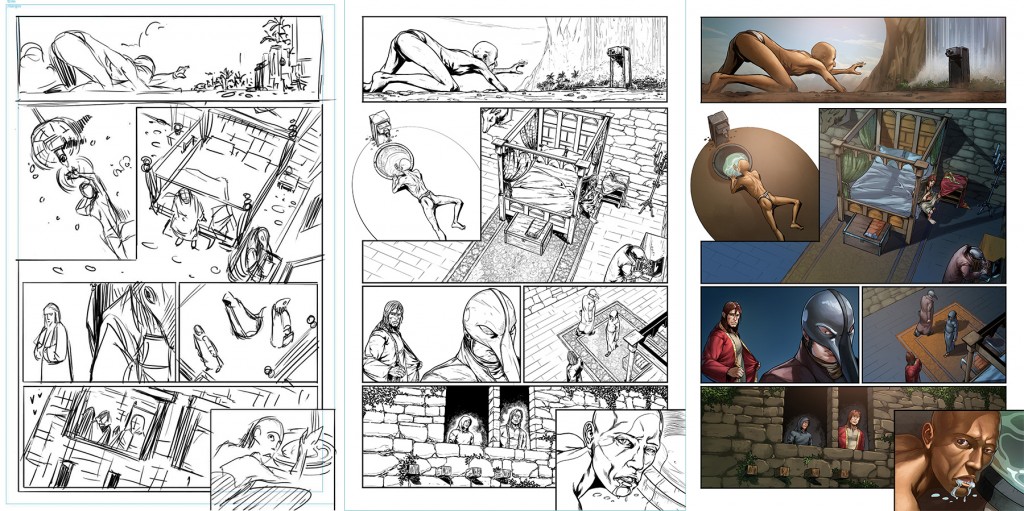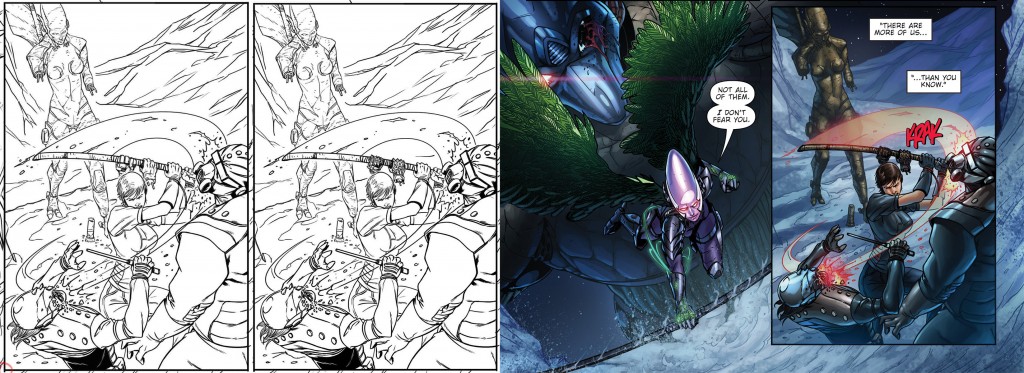You’ve worked out your tone, the character design sketches, and are ready to write those panels, right? Great! The format of your pages is entirely up to you, your artist, and your editor. Heck, you could text message or tweet a description of each panel if you wanted to! But the main point is to get on the same page, and this is done by finding a common language before you begin.
First, make sure that both you and the artist are using the same terminology regarding camera angles; you should both understand them the same way. I use a combination of wide shots, medium shots, close-ups, extreme close-ups, aerial views, and “worm’s eye” views to describe my scene. Anything more complicated than that, like a fish-eye lens shot through a peephole, and I’d describe it in detail in the panel description. You should work with your artist outside of the script to hammer down the details of your common language.
Still Images
Comic book panels are still images. As a writer of this technical document, you need to be aware of that. Nothing can move or be drawn to literally represent that movement. There is frequently action, but there is rarely an attempt to capture movement.
For example:
Panel 1. HARRY reaches for the gun.
The panel is still—Harry can’t move. This is fixed line art. You will need to describe Harry’s actual location. Is he just starting to reach for the gun? Is he milimeters away? In your panel descriptions, be clear about the position of things. Where is Harry’s arm? In some rare cases you might choose to “ghost” part of the picture by drawing multiple states of action, like in the Flash.
Don’t write: The motorcycle jumps off the ramp. That’s not helpful to your artist. Write where the bike is. Has it barely left the ramp? Has it reached the height of its arc? Is it on the downward slope? Is it just about to touch the pavement? Write descriptions that are possible to interpret. Write where things are in relation to other things, plain and simple. If you don’t, the artist will make something up that seems logical to them. And at that point, you’d better hope you put revisions in the contract!
Detail
How much detail should you put into your panel descriptions? This can be a major point of contention. But if you’ve noticed a theme by now throughout this topic, it’s that the writer-artist relationship is key to making your comic book work. Some writers draft lengthy panel descriptions. Look at a few scripts by Alan Moore—they’re massive! Others write sparse descriptions, giving the art more breathing room. This is totally up to you. I tend to describe my panels from left to right, foreground first and then background descriptions if necessary. As a writer of a visual medium, it’s your job to think visually. Even though you aren’t an artist, you should have a vision in your head regarding the flow of the panel and the flow of the page. You might have to draw some stick figures in boxes to make sure your panels and pages work, but you must be thinking visually. I even describe to my artist the panel size and type—sometimes I want a long, horizontal panel running across the whole page, other times I want a series of small panels. Do the best that you can on your side to make a story told with pictures.
But don’t assume you’re as good at it as your artist! The relationship between you and the artist will determine how much detail you include in your panel descriptions, versus how much the artist can improvise to make the page better. Yes, relationships again. If you’ve taken the time to work out a common language, tone, and agreed-upon character designs, it should work out beautifully.
Format
My script format is simple. I write which panel it is, followed by a period. I then describe the panel, with the character names in caps. Underneath, I write the character names and their dialogue. I might also include specific notes to the letterer and colorist (which I’ll talk about later). Early in the script, I write much longer panel descriptions. I micromanage every posture and gesture, and even describe how the faces should look.
Panel 2. Large panel. SEVARA, in no armor—just her simple brown costume and a cloak, kneels on the grass. Her left arm is straight out to the side, holding her staff—which sticks into the ground and stands straight up and down. Her other arm is wrapped around ALATHEA and stretches all the way around, holding her wrist. ALATHEA is curled-up between SEVARA’s legs. ALATHEA sits on the grass—still holding the knife while SEVARA holds her wrist—so that SEVARA is hugging ALATHEA to her body. ALATHEA is staring into space—dazed—and whatever rage had come over her is now gone.
As the script progresses, however, I know my artist “gets it” by now and I drop almost everything but what is necessary.
Panel 7. Wide shot. In the middle of the frame, the BELIEVER has just finished a full baseball-bat swing with the piece of the stone staff. In the foreground, the two thugs snap their heads back, having both been hit squarely in the jaw. We can see the rest of the weathered statue of SEVARA in the background.
The bottom line is this: if something is important, you have to tell your artist. If something must or must not be seen, then you have to tell your artist. Something like “make sure we can see her face” or “make sure you can’t see inside the book” or “we can’t see the attacker’s face” or “we don’t know where the shot is coming from,” etc. You may intend for there to be an element of paradox, sarcasm, or juxtaposition that may not be explicitly obvious to the artist. Your artist can’t read your mind. They don’t know what you’re planning for issue 816. They may not have read to the end of the script for this comic book. So if something needs to be in the panel you have to write it!
Gutter Time and Pacing
We’ve spoken about how a panel is a still image, and only attempts to portray motion in rare instances. The action happens in-between the panels. Paradoxically, these still images have word and thought balloons, which take time to read. Make sure not to pack too many words into a still image that is meant to happen in a heartbeat. For example, many comic book heroes in mid-punch, mid-swing, or mid-fall, somehow manage to blurt out three full minutes worth of dialogue. If you have a panel that compresses a lot of time, then of course feel free to throw in a lazy afternoon’s worth of dialogue.
makingcomics.com

